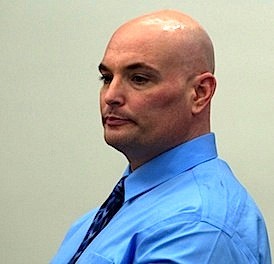 Nobody alive saw Eric Naposki enter William McLaughlin's Newport Beach house, fire six hollow-tip bullets into the wealthy businessman's torso and flee the murder scene on Dec. 15, 1994. Nobody found McLaughlin's blood spatters on the former NFL linebacker. Nobody detected gunshot residue on his hands. Nobody ever asserted that Naposki confessed to the killing.
Nobody alive saw Eric Naposki enter William McLaughlin's Newport Beach house, fire six hollow-tip bullets into the wealthy businessman's torso and flee the murder scene on Dec. 15, 1994. Nobody found McLaughlin's blood spatters on the former NFL linebacker. Nobody detected gunshot residue on his hands. Nobody ever asserted that Naposki confessed to the killing.
Yet, regardless of those undisputed facts, the best prosecution witness in Naposki's ongoing murder trial inside Orange County's central courthouse has been, well, Naposki. And he's accomplished that feat without testifying.
Indeed, it's almost guaranteed that without his post-murder statements to police detectives, the case against him wouldn't have ever made it into a courtroom.
]
Taped interviews demonstrate that Naposki repeatedly lied about his dating relationship with the victim's live-in girlfriend, Nanette Johnston, who prosecutor Matt Murphy calls a co-conspirator. He lied about never using firearms. He distanced himself from 9 mm ammunition and the fact that prior to the murder he bought a Beretta 92F when nobody but police and the killer knew that a Beretta 92F using 9 mm bullets dropped the wealthy 55-year-old businessman to his kitchen floor. He claimed he didn't care one iota about McLaughlin but had scribbled the man's license plate number in his personal notebook. He didn't tell police he owned a storage facility that contained three new motorcycles Johnston had purchased using McLaughlin's money just hours after his funeral.
Police eventually learned that even though Naposki and Johnston had no assets of their own, they spent the months before the killing shopping together for an Irvine home worth just under $1 million and told a Realtor they would buy when they received an expected financial windfall. McLaughlin wasn't aware of Johnston's relationship with the former member of the New England Patriots and Indianapolis Colts. He unwittingly made his death her Lotto jackpot by leaving her more than $1,150,000 in his will.
Despite that evidence, the real dupe in the case is Naposki, who was oblivious to Johnston's murderous intentions that made her, not him, instantly rich, according to his defense lawyers.
But it was Naposki's bumbling, ham-fisted efforts to establish an alibi that could be the most devastating to his defense when jurors begin deliberations early next week. Why? There is this: Does an innocent person work to fabricate an alibi?
And this: There are decisive, provably honest alibis. There are inadvertently weak alibis and there are blatantly manufactured alibis.
Naposki's shifting statements look manufactured. Eight days after the murder, detectives asked him to explain his whereabouts around the time of the killing. He said that after he and Johnston attended a youth soccer match in Walnut, she dropped him off at his Tustin apartment at about “9 or 9:15” p.m.
“She dropped me off and took off,” Naposki told Newport Beach Police Detective Thomas Voth. “And I got dressed and went to work later on, probably around 9:30 or quarter to 10.”
(On the night of the murder, Johnston failed to tell police that she had spent the hours before the crime with Naposki and had asked a person who'd seen them at the soccer match to keep that fact from probing detectives.)
By placing himself about 13 miles away from the 9:10 p.m. murder, Naposki had voiced his first attempt at an alibi. But jurors have learned that the answers, to be kind, weren't accurate. And, once again, the defendant can blame himself because he would later abandon his first story and claim his key, contradictory alibi was an alleged 8:52 p.m. calling-card payphone call from a Denny's in Santa Ana.
In one version, Naposki says he first left his apartment at about 9:30 or 9:45. Then, in another version, he has himself leaving at least 50 minutes earlier so that he can put himself at the Denny's. That's quite a discrepancy. Will jurors notice?
Defense lawyer Angelo MacDonald has called the alleged 8:52 call from 17th Street and the 55 Freeway “a solid, reasonable, logical” alibi that made it “impossible” for Naposki to have traveled to Pacific Coast Highway in Newport Beach and shoot McLaughlin. To support that contention, the defense called private investigator James Box, who claimed he drove the route (55 to Newport Boulevard to its intersection with PCH) in almost 22 minutes. That means Naposki would have arrived about five minutes after the killing.
Box also claimed the 22-minute time frame wasn't fair to Naposki because he would have faced worse traffic. He explained that McLaughlin's murder occurred on the first night of popular annual Newport Beach boat parade. That congestion, he said, would have substantially delayed Naposki's trip even more.
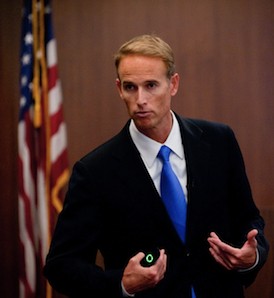 But Murphy eviscerated Box's credibility. He got the former Garden Grove cop and organized-crime investigator in the District Attorney's office to reluctantly admit that he took a prolonged route to the murder scene and therefore had inflated the timing necessary to accomplish the crime. Jurors have heard that law enforcement officials repeatedly tested the direct route and consistently made it to McLaughlin's house in less than 15 minutes, which would have given Naposki plenty of time to carry out the murder.
But Murphy eviscerated Box's credibility. He got the former Garden Grove cop and organized-crime investigator in the District Attorney's office to reluctantly admit that he took a prolonged route to the murder scene and therefore had inflated the timing necessary to accomplish the crime. Jurors have heard that law enforcement officials repeatedly tested the direct route and consistently made it to McLaughlin's house in less than 15 minutes, which would have given Naposki plenty of time to carry out the murder.
(In one of the trial's most dramatic moments, Murphy got Box to repeat his claim that he'd personally verified with Chamber of Commerce officials the Dec. 15, 1994, start of their boat parade. The prosecutor then displayed a copy of a Los Angeles Times article that noted a Dec. 17, 1994, boat parade launch. Incredibly, Box remained argumentative. So, Murphy produced a signed letter from Chamber President Richard Luehrs, who declared the Dec. 17 date was correct. Box glared at the prosecutor with contempt and still refused to concede he'd misled the jury. The following day Murphy summoned Luehrs to the witness stand; the longtime Chamber official declared that it would have been ridiculous for anyone on his small staff to claim the parade began on Dec. 15 when for the 20 years surrounding 1994 it had always started on Dec. 17. The trampling left defense lawyer Gary Pohlson no choice but to ask Box if he'd “purposefully” tried the mislead the jury. “No,” the PI huffed.)
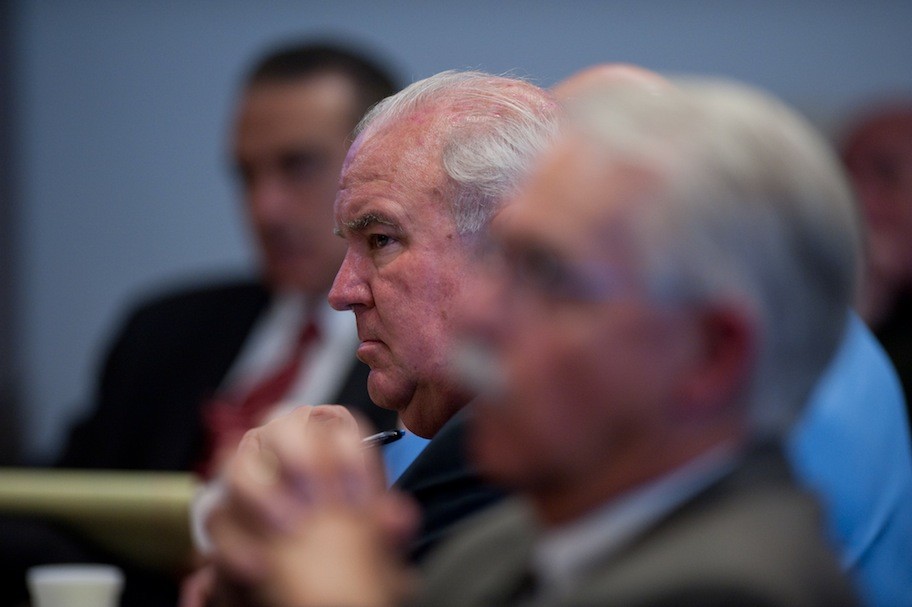 But the defense continued to hail the alleged 8:52 p.m. payphone call as all the reasonable doubt jurors need to let Naposki walk out of the courthouse a free man. I say alleged because there is no phone record of the call. One of the two people Naposki lawyers called to say they saw the record before it was lost by the defense was Box, but I'm not sure you could trust him if he said, “Good morning!”
But the defense continued to hail the alleged 8:52 p.m. payphone call as all the reasonable doubt jurors need to let Naposki walk out of the courthouse a free man. I say alleged because there is no phone record of the call. One of the two people Naposki lawyers called to say they saw the record before it was lost by the defense was Box, but I'm not sure you could trust him if he said, “Good morning!”
Murphy believes the 8:52 call is imaginary and that it doesn't make sense given any of the alibi versions Naposki proposed in police interviews. Here's why: Phone records show that he and Johnston left the soccer field by 8:24 p.m. It takes about 26 minutes to get to Naposki's Tustin apartment near Edinger—meaning he arrived home at about 8:50 p.m.
Naposki assured police that Johnston dropped him off in his apartment complex's parking lot, he walked to his unit, changed clothes and walked back to his vehicle in the parking lot.
Murphy to Box: How much time would Naposki need to do all of that? Answer: About six minutes, which is extremely conservative given that Naposki told police he spent about 15 or 30 minutes inside his apartment before leaving.
The prosecutor then asked Box if he was aware of any “Bermuda Triangle-type problems” on the night of the murder that would have altered the “space-time continuum.”
“No,” he meekly replied, apparently anticipating that he was going to be embarrassed again.
Murphy asked the PI how Naposki made a payphone call from Denny's at 8:52 p.m. when he couldn't have left his apartment complex parking lot, three miles away, until no earlier than 8:56 p.m.
With all the jurors staring at him, a defeated, red-faced Box sat there looking uncomfortable.
But Naposki's alibi is even more troubling than that scenario. For some reason (perhaps to keep himself away from the 9:10 p.m. murder), he added another bizarre trip to his alibi. Though he claimed he was in a rush to get to work and was already late, he told police he also drove northbound on the 55—in the opposite direction of his Newport Beach job—to visit a friend who lived in North Tustin. (He gave no reason for making the trip.) He did say, however, that he drove by the man's house, then turned around, drove to Denny's, made his call and then drove to his job at the Thunderbird nightclub across the street from McLaughlin's home.
Here's the bizarre timeline for that alibi: He leaves his apartment complex at 8:56 p.m. and takes a seven-mile diversion before arriving at the Denny's to make an 8:52 p.m. call.
The Twilight Zone missed an exciting episode.
By the way, the person Naposki claims he called that night doesn't remember it.
(MacDonald has attempted to convince jurors that Naposki arrived at his parking lot by 8:48 p.m., but, as best I recall, the New York-based lawyer never got a witness to introduce that piece of evidence. What he did was load that assertion into one of his questions: Wasn't Johnston's Cadillac STS fast? Of course, questions by lawyers are not evidence and Naposki decided not to brave a battle with Murphy by taking the witness stand. In the final analysis, magically shaving four minutes from the trip still would not have given Naposki time to make the 8:52 p.m. call—unless—could it be? He used a shortcut to go back in time in one of those wormholes Morgan Freeman has been yapping about on a science documentary series.)
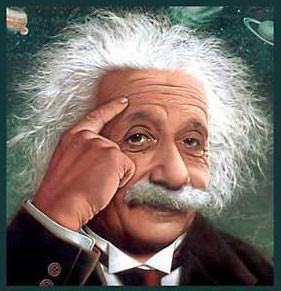 How about a different scenario? There was no 8:52 call. Johnston drove Naposki from Walnut directly to Newport Beach, dropped him off and went to South Coast Plaza. After the crime, Naposki jogged the 52 seconds it takes to get from the crime scene to the Thunderbird.
How about a different scenario? There was no 8:52 call. Johnston drove Naposki from Walnut directly to Newport Beach, dropped him off and went to South Coast Plaza. After the crime, Naposki jogged the 52 seconds it takes to get from the crime scene to the Thunderbird.
It sure would be nice to know what Johnston and Naposki said to each other during their phone conversation at about 1:40 a.m. on Dec. 16, 1994, just after police let her leave the crime scene and when Naposki might have needed a ride home from his job.
Could Naposki have asked, “Do police suspect us?” and “When are you coming to pick me up?”
Maybe she asked him, “Why did you stupidly leave the house key in McLaughlin's front door?”
Sure, I'm speculating, but that scenario seems more plausible than the space-time-warping 8:52 phone call alibi.
In its closing argument on Monday, the defense—Naposki is fortunate that he has two superb, veteran lawyers—undoubtedly will try to explain why I am mistaken.
—R. Scott Moxley / OC Weekly
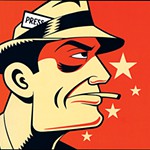
CNN-featured investigative reporter R. Scott Moxley has won Journalist of the Year honors at the Los Angeles Press Club; been named Distinguished Journalist of the Year by the LA Society of Professional Journalists; obtained one of the last exclusive prison interviews with Charles Manson disciple Susan Atkins; won inclusion in Jeffrey Toobin’s The Best American Crime Reporting for his coverage of a white supremacist’s senseless murder of a beloved Vietnamese refugee; launched multi-year probes that resulted in the FBI arrests and convictions of the top three ranking members of the Orange County Sheriff’s Department; and gained praise from New York Times Magazine writers for his “herculean job” exposing entrenched Southern California law enforcement corruption.

